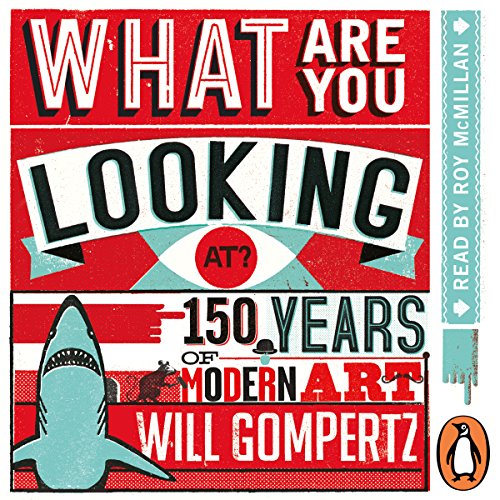This week, I’m going to be discussing Audible’s version of Will Gompertz’ seminal work on 150 years of Modern Art – What Are You Looking At?
What Are You Looking At?

Tate Modern
Tate Modern recently overtook the British Museum as London’s premier tourist attraction – more than 5.8 million of us visited in 2018.This is quite remarkable considering, as a nation, we often seem to be so snide about modern art.
Don’t we just love to laugh at those who call an unmade bed, or a bunch of bricks, or even a pickled shark, ‘art’? Aren’t we Daily Mail-exasperated by the fact that many of our leading artists can’t paint or sculpt but merely express an idea to countless unidentified minions who go on to create their masterpieces?
Come on, admit it, sometimes you’ve looked at modern art in despair and wished that you were at an exhibition displaying works by someone who could actually paint or sculpt, rather than the mess in front of you, which looks like a 5 year old has smeared a mud pie on the wall.
If any of this sounds familiar to you, then What Are You Looking At? is the Audible book for you!
Picasso
My personal feeling is that modern art is unusually reliant about the viewer having some context about the artist and their intention in creating their piece.
A replica of Picasso’s Guernica used to hang above my Headmaster’s head in the school dining hall and it mystified me. Even when he spent an assembly telling us about Nazi Germany’s three hour bombing of the town in 1937, I understood the horror of what it depicted but the style still left me confused, even cold.
It was only when someone explained to me that Picasso was attempting to capture movement in his painting that the picture came to life for me. Indeed, when you ‘animate’ the painting in your head, the result is quite extraordinary. With this knowledge, suddenly the odd placement of the eyes is a woman violently twisting her head in agony at the death of her child, the bull is turning his head to look at us accusingly, the lamp is thrust into the centre, casting light on the nightmarish writhing of body parts.
If you bring it to life in this way, you will have your own experience – not forgetting that Picasso said, ‘It’s up to the public to see what they want to see’.
What I am suggesting Will Gompertz has done in this excellent book is what someone once did to Picasso for me – he illuminates some of the thinking behind the most famous pieces of modern art and what the artists were hoping to express and encourages you to reassess their work in this new light.
Duchamp
Gompertz takes one of the most derided examples as the object from which modern art ‘flows’ – Duchamp’s Fountain (1917). An ordinary porcelain urinal – this item might best capture the absurdity of this new ‘wave’. How ridiculous! How can this be art?
However, once you know that Duchamp was in on the joke, I would suggest that your feelings towards it might change. ‘Fountain’ was submitted for the inaugural exhibition of the Society of Independent Artists, of which Duchamp was a board member, and he duly expressed outrage when the board desired to suppress the piece (not knowing that Duchamp had submitted it). Thus, Duchamp was in on the joke and trying to be provocative. However, he was also trying to make a point – that, as an artist, his very selection of the piece, gave it significance, even a humble urinal.
Duchamp’s challenge to the notion of ‘what is art’ thus explains so much that puzzles the average visitor, right up to an obvious successor – Tracy Emin’s My Bed.
Emin’s mess of a bed and the detritus around it inspires many to sling at it the accusation that anyone could have exhibited that but her response is key – ‘Well, they didn’t, did they? No one had ever done that before’. Exactly.
Saatchi bought it for £150,000, which you might think absurd, until you discover that it went on to be auctioned at Christie’s in July 2014 for a little over £2.5 million.
Pollock
Gompertz provides vignettes of various artists and ably brings them to life, in a fairly ‘warts and all’ manner.
Jackson Pollock, Gompertz tells us, gave life to ‘action painting’, where the event of creation was more important than the finished article. Indeed, when I learned of the pain and emotion behind Pollock’s drip paintings, fired by his struggle with alcoholism, they spoke to me a little better. This understanding, coupled with the fact that Pollock died tragically young in a single-car crash at just 44, helped explain, at least a little bit more, why someone might pay $200 million for his Number 17A.
Gompertz also looks at the entrepreneurs and driving forces behind modern art. His exploration of Pollock, for instance, allows Gompertz to take an intriguing stroll through the exploits of the canny art collector, Peggy Guggenheim, who was the first to see Pollock’s genius.
In Conclusion
What Are You Looking At? Is well-read by Roy McMillan and an entertaining listen. Intelligent but never inaccessible.
Ultimately, Gompertz encourages us not to be intimidated by modern art but to revel in it. I promise that, after listening to this book, your next gallery trip will be whole lot more interesting!

